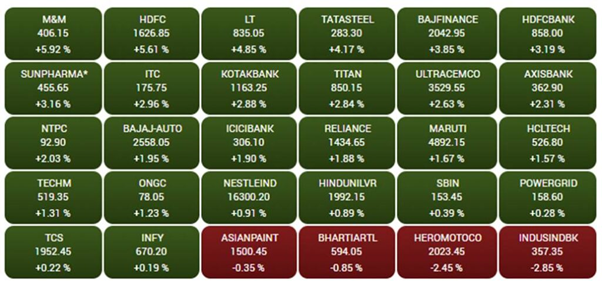To understand Equity Investments or Mutual Funds one has to understand basics of Stock Market
Some of the basics terms have been explained below:-
What Are Stocks
Stock is a share in the ownership of a company. Suppose Reliance Industries has 300 crore shares and if you have even 1 share of RIL then technically that makes you a shareholder in the company( however small your ownership maybe).
Public Company And Private Company?
In a private company the shares are not available for the general public through the stock exchange, it may have private investors/shareholders. For a public company, the shares are available in the stock exchange for people to own/trade. The stock exchange is a medium for people to buy/sell their shares.
What Happens To The Money From The Shares
When a company goes for IPO(initial public offer) then the money raised by selling the shares is utilised in the company for their business. The profits made are usually utilised to further grow the company and the leftover profit after company expansion plans are given to shareholders as Dividends.
Why Does The Share Price Go Up Down
As the company does business and makes a profit, the profit is further utilised to grow the company and increase its assets, which will likely help them make more profit. As the number of shares remains the same and the company assets/business/profits grow then people see this and are willing to pay more money per share and because of this demand the share price goes up. (remember it’s the demand and supply that governs the price of anything in general). Also, the dividends would increase with the growth of the company.
Similarly, if people see a bad business model, a company not making a profit, bad business ethics and they predict the company to do badly in future then not many people would like to buy such a company’s share. Rather more people would want to sell such shares and because of less demand, the price goes down to the point where people are still willing to buy it.
A company may not actually make any profit, it may be making a loss, but if people see it as a very good business model that will earn great profits in the future, this will drive the share prices up because of the high demand. For example, 1% of Paytm shares(it’s a Pvt company though) were sold by the founder at 350 crores to raise money for Paytm bank. This technically makes Paytm a 35000 crore company. If Paytm goes public there is likely to be huge demand because of which its share prices may go even higher just because people see it as a good business model. As of now Paytm is not making any profits but still, the value of the company is going up. This is because of a good business model and the likelihood of good future earnings.
What Causes A Stock Market Crash
When people go on a selling spree due to whatever reasons/fears then the share prices of most companies fall rapidly which is termed a crash. However, if you go and see the companies they may not be affected at all, they may just go about their activities as usual. For example, Tata Motors share price has fallen from 600 to 150(2018) as people fear that due to the Brexit issue its subsidiary company Jaguar Land Rover may get affected and hence they went on a selling spree. Tata’s actual assets haven’t gone down though and if you visit their factory they continue to make more vehicles, newer cars etc. It may go 10 times up in a year for some other company due to the company getting a very good order, etc. So share price at times represents the behaviour of people which may be crazy/irrational in short periods. In the long run the share prices always almost follow the actual growth of the company.
What Is Sensex
The SENSEX-(or sensitive index) was introduced by the Bombay stock exchange on January 1 1986 and it is one of the prominent stock market indexes in India. The Sensex is designed to reflect the overall market sentiments and comprises of 30 stocks. These are large, well-established and financially sound companies from main sectors. The companies in Sensex are in a certain ratio, for example, Reliance Industries is around 10% of Sensex. The smallest of Sensex companies like NTPC may consist of around 2% of Sensex. Reliance Industries market cap is 7 lakh crore and that of NTPC is 1.27 lakh crore(market cap =total no of shares x share price). So say if Reliance share price doubles then Sensex will increase by 10%. The base year of Sensex is 1979 so in 1979 the sum of share prices of the Sensex companies in the ratio they constituted Sensex was 100 Rs. So Sensex began with 100 points in 1979. On 10 Nov 18, it is close to 35000.
Sensex is an index that is used to view the general trend of the market. There are other indexes like Nifty 50( Top 50 companies in National Stock exchange which is Sensex 30 plus another top 20 companies). Some of the US indexes are Dow Zones( top 30 companies- very big companies), Nasdaq100( top 100 mostly technology companies like Apple, Facebook, Tesla etc), S& P 500( top 500 US companies). Unlike Sensex, the Dow Zones Index has been there for more than 120 years so America has more history to study in terms of the stock market. Various people study US market history to gather more knowledge about the stock market just like we study history. History repeats itself you see.
Sensex companies have grown at a CAGR(compounded aggregate growth rate) of 16% since inception. So if somebody invested 100 rs in Sensex companies in the same ratio as they constitute the Index it would be Rs 35000 today(2018). Our GDP is 7-8 % and inflation is 7 % so as a nation we are growing at 14-15%. You can see the Sensex growth is very close to the nation’s growth.
Sensex Companies as of 2020 are shown in the picture below

Watching the movement of Sensex gives a fair idea of the stock market trend. If Sensex shares fall then most of the others fall but the fall of the smaller companies is likely to be more. Sensex represents the general mood of the public in the stock market.
Most MF companies have a Sensex fund. It contains Sensex companies in a similar ratio. It is a passive fund( the fund manager does not decide which shares to buy). This fund is likely to give you 14% returns in long term. Since India is a growing economy an active fund( consisting of actively selected funds or a mix of big, medium and small companies ) is likely to have more growth than the top 30 companies). In the US where the market is saturated, it is very difficult to find undervalued stocks so passive funds like S & P 500 yield better returns than active funds hence people mostly invest in Index funds there.

